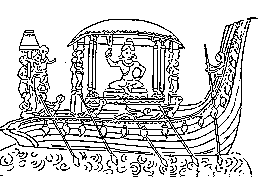Shipbuilding And Navigation
By Sudheer Birodkar
This is even reflected in folklore--The Satya-Narayana Puja, talks of a sea merchant who was caught in a storm and prayed to the lord that if he is saved he would offer a puja to Lord Satya-Narayana.
In Ancient times, India had colonies, in Cambodia (Kambuja in Sanskrit) in Java, (Chavakam or Yava dwipa) in Sumatra, in Borneo, Socotra (Sukhadhara) and even in Japan. Indian traders had established settlements in Southern China, in the Malayan Peninsula, in Arabia, in Egypt, in Persia, etc., Through the Persians and Arabs, India had cultivated trade relations with the Roman Empire[1].
Shipbuilding Handbook From the Ancients[edit]
Sanskrit and Pali literature has innumerable references to the maritime activity of Indians in ancient times. There is also one treatise in Sanskrit, named Yukti Kalpa Taru which has been compiled by Bhoja Narapati.[2][3]
This treatise gives a technocratic exposition on the technique of shipbuilding. It sets forth minute details about the various types of ships, their sizes, the materials from which they were built. The Yukti Kalpa Taru sums up in a condensed form all the available information at the time of its compilation.
The Yukti Kalpa Taru gives sufficient information and date to prove that in ancient times, Indian shipbuilders had a good knowledge of the materials which were used in building ships. Apart from describing the qualities of the different types of wood and their suitability in shipbuilding, the Yukti Kalpa Taru also gives an elaborate classification of ships based on their size.
The primary division is into 2 classes viz. Samanya (ordinary) and Vishesha (Special). The ordinary type for sea voyages. Ships that undertook sea voyages were classified into, Dirgha type of ships which had a long and narrow hull and the Unnata type of ships which had a higher hull.
The treatise also gives elaborate directions for decorating and furnishing the ships with a view to making them comfortable for passengers. Also mentioned are details about the internal seating and accommodation to be provided on the ships. Three classes of ships are distinguished according to their length and the position of cabins. The ships having cabins extending from one end of the deck to the other are called Sarvamandira vessels. These ships are recommended for the transport of royal treasure and horses. The next are the Madhyamarnandira vessels which have cabins only in the middle part of their deck. these vessels are recommended for pleasure trips. And finally there is a category of Agramandira vessels, these ships were used mainly in warfare.
Maccha - Yantra - The Ancient Indian Mariner's Compass[edit]
Interestingly there were Sanskrit terms for many parts of a ship. The ship's anchor was known as Nava-Bandhan-Kilaha which literally means 'A Nail to tie up a ship' . The sail was called Vata Vastra a which means 'wind-cloth'. The hull was termed StulaBhaga i.e. an'expanded area'. The rudder was called Keni-Pata, Pata means blade; the rudder was also known as Karna which literally means a 'ear' and was so called because it used to be a hollow curved blade, as is found today in exhaust fans. The ship's keel was called Nava-Tala which means 'bottom of a ship'. The mast was known as Kupadanda, in which danda means a pole.
Even a sextant was used for navigation and was called Vruttashanga-Bhaga. But what is more surprising is that even a contrived mariner's compass was used by Indian navigators nearly 1500 to 2000 years ago. This has in fact been the suggestion of an European expert, Mr. J.L. Reid, who was a member of the Institute of Naval Architects and Shipbuilders in England at around the beginning of the present century stated
The early Hindu astrologers are said to have used the magnet, in fixing the North and East, in laying foundations, and other religious ceremonies. The Hindu compass was an iron fish that floated in a vessel of oil and pointed to the North. The fact of this older Hindu compass seems placed beyond doubt by the Sanskrit word Maccha Yantra, or fish machine, which Molesworth gives as a name for the mariner's compass.[4]
It is quite possible that the Maccha Yantra (fish machine) was transmitted to the west by the Arabs to give us the mariner's compass of today.
References[edit]
- ↑ Kennedy J., Journal of Royal Asiatic Society 1898, on the early commerce between India and Babylon
- ↑ The Yukti Kalpa Taru (YKT) has been translated and published by Prof. Aufrecht in his 'Catalogue of Sanskrit Manu scripts
- ↑ A study of the Yukti Kalpa Taru has been undertaken by Dr. Radha Kumud Mookerji entitled 'Indian Shipping'. Published by Orient Longman, Bombay in 1912.
- ↑ J.L. Reid, Bombay Gazetteer, vol. xiii., Part ii., Appendix A
- Elphinstone, History of India Cowell’s Edition P. 185
- K.M. Pannikkar, India and the Indian Ocean, George Allen and Unwin (India) Bombay (Mumbai) 1961 P. 28



